Josh Alan Friedman's Blog, page 6
August 6, 2012
"I'll See You in My Dreams"
I have a recurring dream, which I will embellish only a little: It is of an old, but not entirely abandoned, amusement park that once rivaled Coney Island—but apparently never existed. An alternate Coney Island on the other side of the borough, North Brooklyn, near the Navy Yard. They have their own trademark mascot, a competitive cousin of the Steeplechase Imp. They have their own famous hot dog joint, an alternate Nathan's. An abandoned subway El runs alongside their own famous roller coaster, both casting rusted-iron shadows. The cityscape is sepia-toned. Nothing is gentrified here whatsoever. When I awake, I feel certain this place exists.
Is this amusement park the foiled plan of some visionary—not George Tilyou or Walt Disney—but some would-be conjuror of mass entertainment whose dreams never got off the ground? Are these the ruins of what never was—as if it once had been?
I walk along the rusted perimeter of this archeological ruin. I sense that a few sparsely attended attractions still operate somewhere inside. The roller coasters, shoot-the-ducks midway games and sideshows are closed. The park had an affiliation with the image of comedian Joe E. Brown—the "Generalissimo of Joy," who was once chairman of National Smile Week. He, too, had a grotesquely overblown smile, like the Steeplechase demon. Brown’s trademark cavernous mouth is on the twin pillars of the park’s main entrance.
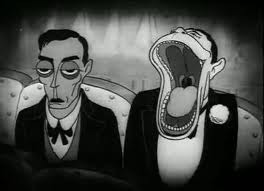
I can barely make out faded depictions of Little Lulu, Popeye, Olive Oyl, Betty Boop and Wimpy on fun houses. Faded ads testify there was once a spin-off here of Auster’s Egg Creams, from the Lower East Side, called Egg Cream Land. And for longshoreman or wayward dads at night, there was The Ritz Bros.' Shayna Tuchas Burlesk.
The park peaked in the 1930s, when Coney was long past its technological prime. It was slightly more modern than Coney, 1930’s state-of-the-art, yet not so futuristic as the 1939 World’s Fair. One concession’s faded logo claimed to have first introduced cotton candy, the first spinning sugar machine. There is a pre-WWII airplane ride for children. Little planes that once rose and fell have lost their original colors; the metal parts have rusted through. Yet, I wonder whether this ride still operates. There’s an abandoned electric-track spook house, with dancing Mr. Bones skeletons on the facade. One advertises a choice of three doors to enter, like the spook house in a Little Rascals short. Its entry doors that burst open are, of course, embossed with the giant mouth of Joe E. Brown.

A creaky hot dog joint around the corner still operates. I head for it. The front entrance swings open like a spring screen door. This joint once competed head-to-head with Nathan’s from the other side of Brooklyn, like the underdog Dodgers against the Yankees. They still serve seltzer bottles and egg creams. I’m one of the only customers present. There are old-timers who swear by it, over Nathan's. But how do they maintain a license to operate, much less a Board of Health rating?
There appears to have been some kind of bathing pavilion—not Brooklyn by the Sea, like Coney Island, but Brooklyn by the River. The East River. The presence of the Manhattan Bridge and the Brooklyn Bridge looms nearby. Tires once swung over barnacled dry docks where kids could leap off and swim. Floats are now obscured in seaweed. Popeye the Sailor's tattooed anchor forearm is on the Admiral's Row pavilion. Some kind of longshoreman ethic once ruled. The skeleton of a carnival tent rusts by the pier, where you could once get an illegal tattoo.
Closer to Manhattan, right over the bridge, these were the stomping grounds of incredible hipster Al Dubin, lyricist of "42nd Street," "Lullaby of Broadway" and "Boulevard of Broken Dreams." His heart belonged here, not in Coney Island, and his enormous girth was enhanced by the hotdogs and egg creams. After all, this park was just a few subway stops from Tin Pan Alley on 28th Street.
People in this part of Brooklyn today seem barely aware that it exists and are indifferent. The amusement park is just over there, always had been, no one pays any attention. Time marched on without it. But is it possible no one ever sees it, just me?
My dream also begs the question of whether New York City, not to mention Brooklyn, could have handled two great amusement parks simultaneously. Well, why not? They nearly supported three major league baseball teams for 75 years. Palisades thrived for 70 years in New Jersey. Freedomland in the Bronx only lasted four. But just how much had these two parks—Coney and The Joe E. Brown Grounds—undercut each other's business over the decades, leading to the demise of both?
In popular song, this park was associated with the ditty "I’ll See You My Dreams." Ukulele Ike performed it there. “Meet Me Tonight in Dreamland” was Coney Island’s most famous song. And by odd coincidence, 50 years later, "I’ll See You in My Dreams" became popular by another, unrelated Joe Brown, the English ukulele player who does fine throwback numbers. Always playing second fiddle, many things were nearly, but not quite the same, as Coney.
© 2012 Josh Alan Friedman
Is this amusement park the foiled plan of some visionary—not George Tilyou or Walt Disney—but some would-be conjuror of mass entertainment whose dreams never got off the ground? Are these the ruins of what never was—as if it once had been?
I walk along the rusted perimeter of this archeological ruin. I sense that a few sparsely attended attractions still operate somewhere inside. The roller coasters, shoot-the-ducks midway games and sideshows are closed. The park had an affiliation with the image of comedian Joe E. Brown—the "Generalissimo of Joy," who was once chairman of National Smile Week. He, too, had a grotesquely overblown smile, like the Steeplechase demon. Brown’s trademark cavernous mouth is on the twin pillars of the park’s main entrance.

I can barely make out faded depictions of Little Lulu, Popeye, Olive Oyl, Betty Boop and Wimpy on fun houses. Faded ads testify there was once a spin-off here of Auster’s Egg Creams, from the Lower East Side, called Egg Cream Land. And for longshoreman or wayward dads at night, there was The Ritz Bros.' Shayna Tuchas Burlesk.
The park peaked in the 1930s, when Coney was long past its technological prime. It was slightly more modern than Coney, 1930’s state-of-the-art, yet not so futuristic as the 1939 World’s Fair. One concession’s faded logo claimed to have first introduced cotton candy, the first spinning sugar machine. There is a pre-WWII airplane ride for children. Little planes that once rose and fell have lost their original colors; the metal parts have rusted through. Yet, I wonder whether this ride still operates. There’s an abandoned electric-track spook house, with dancing Mr. Bones skeletons on the facade. One advertises a choice of three doors to enter, like the spook house in a Little Rascals short. Its entry doors that burst open are, of course, embossed with the giant mouth of Joe E. Brown.

A creaky hot dog joint around the corner still operates. I head for it. The front entrance swings open like a spring screen door. This joint once competed head-to-head with Nathan’s from the other side of Brooklyn, like the underdog Dodgers against the Yankees. They still serve seltzer bottles and egg creams. I’m one of the only customers present. There are old-timers who swear by it, over Nathan's. But how do they maintain a license to operate, much less a Board of Health rating?
There appears to have been some kind of bathing pavilion—not Brooklyn by the Sea, like Coney Island, but Brooklyn by the River. The East River. The presence of the Manhattan Bridge and the Brooklyn Bridge looms nearby. Tires once swung over barnacled dry docks where kids could leap off and swim. Floats are now obscured in seaweed. Popeye the Sailor's tattooed anchor forearm is on the Admiral's Row pavilion. Some kind of longshoreman ethic once ruled. The skeleton of a carnival tent rusts by the pier, where you could once get an illegal tattoo.
Closer to Manhattan, right over the bridge, these were the stomping grounds of incredible hipster Al Dubin, lyricist of "42nd Street," "Lullaby of Broadway" and "Boulevard of Broken Dreams." His heart belonged here, not in Coney Island, and his enormous girth was enhanced by the hotdogs and egg creams. After all, this park was just a few subway stops from Tin Pan Alley on 28th Street.
People in this part of Brooklyn today seem barely aware that it exists and are indifferent. The amusement park is just over there, always had been, no one pays any attention. Time marched on without it. But is it possible no one ever sees it, just me?
My dream also begs the question of whether New York City, not to mention Brooklyn, could have handled two great amusement parks simultaneously. Well, why not? They nearly supported three major league baseball teams for 75 years. Palisades thrived for 70 years in New Jersey. Freedomland in the Bronx only lasted four. But just how much had these two parks—Coney and The Joe E. Brown Grounds—undercut each other's business over the decades, leading to the demise of both?
In popular song, this park was associated with the ditty "I’ll See You My Dreams." Ukulele Ike performed it there. “Meet Me Tonight in Dreamland” was Coney Island’s most famous song. And by odd coincidence, 50 years later, "I’ll See You in My Dreams" became popular by another, unrelated Joe Brown, the English ukulele player who does fine throwback numbers. Always playing second fiddle, many things were nearly, but not quite the same, as Coney.
© 2012 Josh Alan Friedman
Published on August 06, 2012 00:02
April 23, 2012
Anatomy of a Comic Strip
From the editor: We're trying something different with this post. The Issuu Reader below takes a moment to get accustomed to, but it's really very simple - and worth the effort. The format delivers a more dynamic reading experience, particularly for lengthier posts such as this one. Give it a try.
Open publication - Free publishing - More black cracker
Bloggers, columnists, critics and fans: Want to share "Anatomy of a Comic Strip" with your readers? Simply click here for links and embed codes.
(Don't like the Issuu Reader? Click here to read "Anatomy of a Comic Strip" in (mostly) standard blog format.)
Open publication - Free publishing - More black cracker
Bloggers, columnists, critics and fans: Want to share "Anatomy of a Comic Strip" with your readers? Simply click here for links and embed codes.
(Don't like the Issuu Reader? Click here to read "Anatomy of a Comic Strip" in (mostly) standard blog format.)
Published on April 23, 2012 02:55
Anatomy of a Comic Strip [blog format]

I’ve sometimes heard people describe me as “the guy who wrote the captions.” Well, captions are part of it. But for me, writing comix involved the conception of an idea, the storyline, dialog balloons, and a precise description of the action in each panel. The blocking of scenes, so to speak. I was never a fan of comics, other than Don Martin or Robert Crumb, but I did have nightmares to get off my chest. And I couldn’t draw them myself.
Before the days of online research, I kept files on shadowy sub-celebrities. I clipped obscure news items and photos from show biz journals, out-of-town papers, made trips to libraries and searched out the scant information then available on Joey Heatherton, Wayne Newton, Joe Franklin, Frank Sinatra, Jr. Seeking reference photos for “Fred’s Night Out,” Drew himself went to Fifth Avenue bookstores with an X-Acto knife, carving Fred heads out of TV histories. I often wondered what Doubleday customers thought when they got home and discovered Fred Mertz’s head missing throughout their coffee table book.
It might take years before I had enough raw information to write a script. Then, I would “art direct” my younger brother Drew. We convened at his Lower East Side tenement apartment as he brought these stories to life. Pointillistic slave labor it was, taking him one full day per panel. He often exceeded my expectations with his other-worldly brilliance. No one else could have drawn these images, from my imagination to his.
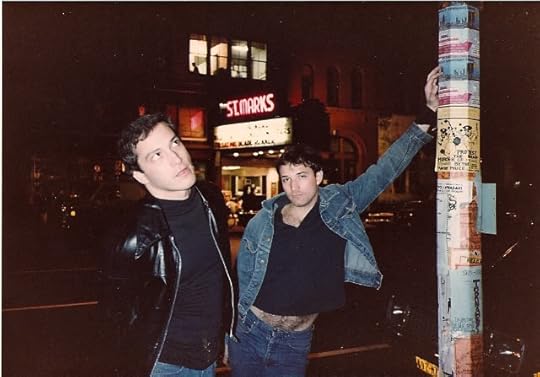 Drew and Josh in the East Village, 1982
Drew and Josh in the East Village, 1982Then I went out into the hardboiled magazine world to try and get our fever dreams published. I hate salesmanship. It was a tough road the first few years dealing with perplexed editors and art directors. They often wanted to assign their ideas, which were typically awful and missed the point of what we did. Attacking the national sickness called celebrity worship, from the gutter looking up. Each comic strip we published felt like a hard-won victory. Screw, High Times, National Lampoon and Heavy Metal became our main outlets.
Posted below is my nine-page script on surreal New York talk-show host, Joe Franklin. Nobody ever considered or bothered to parody him, even after decades as an enigma on the local airwaves. What went down on Joe Franklin’s Memory Lane in the wee hours was often more bizarre than anything depicted in our comic strips. Milton Berle repeatedly telling him to shut up, Gig Young drunk the night before his murder-suicide. Scenes and questions so jaw-droppingly inane that you couldn’t believe your eyes and ears. And no one else was watching (precious little video or kinescopes from the first 25 years survives).
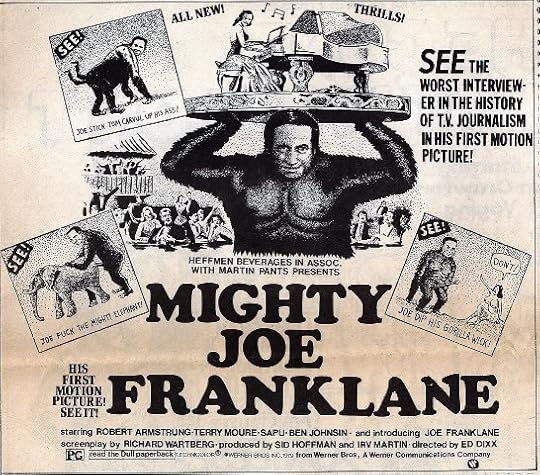 These cheap shots, created at the expense of Joe Franklin, appeared in Screw, '79.You can make absolutely anyone look foolish, and I regret doing this to Joe.
These cheap shots, created at the expense of Joe Franklin, appeared in Screw, '79.You can make absolutely anyone look foolish, and I regret doing this to Joe.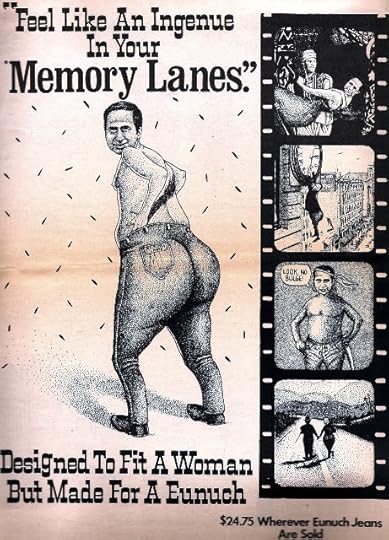
Something had to be done. In the late ’70s, we began slipping Joe into parody ads for Screw. Joe depicted as the great ape, Mighty Joe Young; Joe Franklin designer jeans. Then came the epic story of his life, which ran in High Times. After this, everyone from Uncle Floyd to Billy Crystal started doing Joe Franklin (and years later, the great Sarah Silverman rape routine). It wasn’t until Drew, on his own, did a one-pager called “The Incredible Shrinking Joe Franklin” in Heavy Metal that Franklin sued for $40 million. It was the most innocuous of all the Franklin strips, and Franklin sued Drew alone. The lawsuit was thrown out of Manhattan Supreme Court (Joe’s legal strategy argued that his advertisers might really believe he was shrinking).
Had the clueless Franklin sued me for libel over the earlier strip below, he might have had a case.
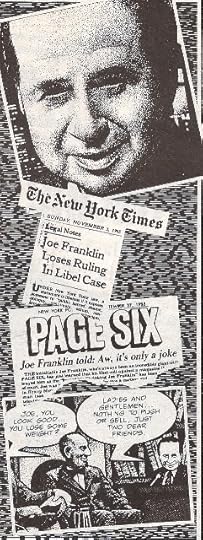
Read Josh's script by clicking EXPAND below:
Open publication - Free publishing - More black cracker
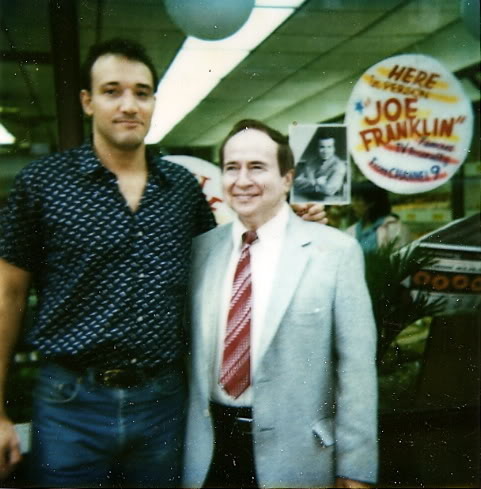
© 2012 Josh Alan Friedman
comix © 1980, 2012 Josh Alan Friedman, Drew Friedman
"The Joe Franklin Story" appears in the Friedman Bros. collection, Any Similarity to Persons Living or Dead is Purely Coincidental, now available in a new edition from Fantagraphics. Order your copy here.
Visit Drew Friedman's blog here.
Published on April 23, 2012 02:54
April 13, 2012
Robert Ward's RENEGADES

Renegades, by Robert Ward
 (Tyrus Books, 2012)
(Tyrus Books, 2012)There once was a certain breed of men (and manly ones, to boot) that specialized in crafting journalistic “pieces” for magazines. Some had yearly contracts to tackle say, six assignments; others freelanced like gypsies on the road. Robert Ward was one such road writer during the last hurrah of “New Journalism,” with notepad, plane ticket and bourbon in hand. Deadlines were their own form of amphetamine.
As a teenager, Bob Ward was so innocent, he “didn’t know mere mortals could even meet Elvis.” He learned this when carousing as a teen with a seafaring vaudevillian who appeared in the 1964 Presley flick, Roustabout. The fellow was a mate of Ward’s sea-captain grandfather. Finally, granddad took Bob himself on as a “mate” one night. Cap Ward introduced his grandson to Baltimore’s waterfront bars, strip dives and Blaze Starr herself. Bob never realized his granddad even knew about such things. Ol’ Cap Ward beats young Bob to the punch, slugging out a longshoreman who insults Bob’s grandmother.
A few years later, Ward trips down the rabbit hole, escaping working-class Baltimore for anything-goes New York. New intros and postscripts to each article give Renegades an autobiographical flair.
We meet the deposed leader of South Vietnam, reduced to operating a liquor store in California. Ward reveals the “core” of painter LeRoy Neiman, the Liberace of art. The Outlaw Country movement in Texas is shown up as an impure enterprise of Capitalism. He’s there during Mark “The Bird” Fidrych’s phenomenal rookie season, wherein the pitcher comes off as baseball’s Gomer Pyle. However, among the athletes profiled, Pistol Pete Maravich and Johnny Unitas earn our highest admiration.
Shadowing Larry Flynt during Hustler’s second year, Ward found his delicate sensibilities offended. Having narrowly escaped atrophy as a young Lit professor at William Smith College, Ward deemed the upstart magazine “gross.”
“I’m here to set the record straight,” he told his subjects. None of them questioned the neutrality of such a claim. Until they saw themselves in print. Hold a mirror up to almost anyone, and they’ll want to kill you.
Ward knew exactly what he was doing on the page, and made his point without stating it pointblank. He could size up a character or scene quicker than a hundred psychiatrists. Unimpressed by mere celebrity. Confronted with pomposity or self-deception, he questioned what’s fake and celebrated what’s real. All those good things, now rare in the dying magazine market, dominated by fluff pieces that submit to publicists and advertisers. Editors left Ward alone, let him do it his way—which is usually the only way a master can work.
© 2012 Josh Alan Friedman
Renegades by Robert Ward is available here
 .
.
Published on April 13, 2012 13:00
March 26, 2012
Next From Josh: WEASELS RIPPED MY FLESH!
"We were lucky—until the weasels..."
New Texture and MensPulpMags.com manfully present

Weasels Ripped My Flesh! A shirt-ripping, gut-punching anthology of two-fisted writing, ripped from the pages of long-lost men's adventure magazines of the 1950s, '60s and '70s. Outrageous, 100% true tales of sex, crime, combat, jungle goddesses, beatnik girls, LSD experiments, animal attacks . . . and nymphos. Always nymphos.
Following his highly regarded contributions to the justly-lauded History of Men's Magazines and It's a Man's World (both men's adventure mag bibles), Josh Alan Friedman contributes essays and rare interviews with some of the heaviest hitters from the pulp mags' glory days.
Steel your nerves for bare-knuckle stories and gutsy reminiscences by some of the toughest writers ever to punch a typewriter: Bruce Jay Friedman, Mario Puzo, Lawrence Block, Robert F. Dorr, Harlan Ellison, Robert Silverberg, Walter Kaylin, Walter Wager, Jane Dolinger, Ken Krippene and more.
Weasels Ripped My Flesh! Edited by Robert Deis, with Josh Alan Friedman and Wyatt Doyle.
Coming this summer from New Texture. Man up.
For updates, watch this space—and subscribe to the MensPulpMags feed on their site, here.
The Weasels Ripped My Flesh! Facebook page is here.

New Texture and MensPulpMags.com manfully present

Weasels Ripped My Flesh! A shirt-ripping, gut-punching anthology of two-fisted writing, ripped from the pages of long-lost men's adventure magazines of the 1950s, '60s and '70s. Outrageous, 100% true tales of sex, crime, combat, jungle goddesses, beatnik girls, LSD experiments, animal attacks . . . and nymphos. Always nymphos.
Following his highly regarded contributions to the justly-lauded History of Men's Magazines and It's a Man's World (both men's adventure mag bibles), Josh Alan Friedman contributes essays and rare interviews with some of the heaviest hitters from the pulp mags' glory days.
Steel your nerves for bare-knuckle stories and gutsy reminiscences by some of the toughest writers ever to punch a typewriter: Bruce Jay Friedman, Mario Puzo, Lawrence Block, Robert F. Dorr, Harlan Ellison, Robert Silverberg, Walter Kaylin, Walter Wager, Jane Dolinger, Ken Krippene and more.
Weasels Ripped My Flesh! Edited by Robert Deis, with Josh Alan Friedman and Wyatt Doyle.
Coming this summer from New Texture. Man up.
For updates, watch this space—and subscribe to the MensPulpMags feed on their site, here.
The Weasels Ripped My Flesh! Facebook page is here.
Published on March 26, 2012 00:04
March 12, 2012
Colored School: Josh Alan at the TED Conference
"My Black Cracker reading at the TED educational conference for teachers. Begin at 11 minutes into the feed."
Published on March 12, 2012 00:02
March 5, 2012
ANY SIMILARITY TO PERSONS LIVING OR DEAD... Back in Print!
From the editor's desk:
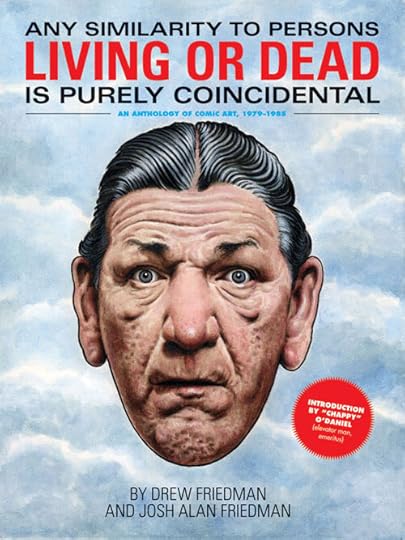
After too long out of print, the Friedman Bros. debut collection, Any Similarity to Persons Living or Dead is Purely Coincidental, is back in print this April! This all-new edition includes new painted covers by Drew and a new introduction by Chester "Chappy" O'Daniel (elevator man, emeritus).
Pre-order your copy at Amazon.com HERE .
.

After too long out of print, the Friedman Bros. debut collection, Any Similarity to Persons Living or Dead is Purely Coincidental, is back in print this April! This all-new edition includes new painted covers by Drew and a new introduction by Chester "Chappy" O'Daniel (elevator man, emeritus).
Pre-order your copy at Amazon.com HERE
 .
.
Published on March 05, 2012 00:01
January 9, 2012
Richard Jaccoma's THE WEREWOLF'S TALE
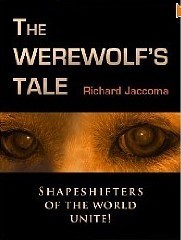
I don't know if he invented the genre—but Richard Jaccoma has melded vampires, werewolves and sex scenes in his fiction longer than virtually any other writer currently in vogue. This, in a volatile mix of Old Lefty politics. Lesbo vampire pirates meet commies, mummies 'n' Nazis. The political slant reflects the leanings of Jimmy Underhill, which gives Jaccoma's detective noir its unique flavor. The pornographic parts merely describe action that would have been omitted in Chandler or Hammett's time. Many of Jaccoma's stories saw light in the men's magazine demimonde, now part of the last century. Jaccoma is, to say the least, a master pornographer.
Any rational thinking reader acquainted with his first novel would be forced to agree on one controversial matter concerning Richard Jaccoma: The Yellow Peril, published in hardcover by Putnam in 1978, contained a point-by-point blueprint for Raiders of the Lost Ark. The Indiana Jones franchise emerged during the following decade. Jaccoma took the gentleman's path, so to speak, and decided to forego unpleasant litigation that might have resulted in a slam-dunk settlement.
He put his energy into a series of high-adventure pulp novels that are only pulp on the surface. The Werewolf's Tale begins in New York, 1939. Poland is on the brink of falling to the Nazis, and Jimmy is drinking off his 1930s sorrows in Germantown on the upper east side of Manhattan. He barroom brawls with Nazi sympathizers from the German-American Bund. Mysterious Asian folks are "Orientals," an incorrect term these days unless referring to rugs. Who would have known that Manhattan was awash in mysticism, the occult and cannibalism?
So will today's youth, whose political consciousness was awakened by Occupy Wall Street, be intrigued by this 1930's brew of Lefty politics and occultism? Would followers of Taylor Swift ("Swifties"), Katy Perry or the Twilight series get turned on by Jaccoma's narratives of violent sex with werewolves? My guess is that The Werewolf's Tale will indeed unlock the disturbed sexual fantasies of teenyboppers. And elevate their social consciousness. Originally published in 1988, it raises the bar a few notches to the Left of Sookie Stackhouse. And will provide young readers the thrills they've paid their money for. Especially when describing the alien spice of the female werewolf's steaming breath; the sweet, pungent musk of her fur, the emerald green glow of her eyes through membranous lids. If that isn't romantic enough, this succubus violently rapes hero Jimmy Underhill, veteran of the Spanish Civil War, fighter of fascists. Artfully plotted, and with more substance than most pulps of yore, Jaccoma wears his politics on his sleeve. And they are correct by righteous standards.
The Werewolf's Tale is now available on Kindle, HERE
 .
.© 2012 Josh Alan Friedman
Published on January 09, 2012 00:01
December 20, 2011
"As Chanukah Passes Me By"
 To watch on YouTube, click the image above. To watch via Vimeo, click below.
To watch on YouTube, click the image above. To watch via Vimeo, click below.© 2002, 2011 Josh Alan Friedman
Video by Wyatt Doyle & Josh Alan Friedman, with artwork by Drew Friedman. Visit DrewFriedman.net
Published on December 20, 2011 23:36
November 24, 2011
"Thanksgiving at McDonald's in Times Square"
 To watch on YouTube, click the image above. To watch via Vimeo, click below.
To watch on YouTube, click the image above. To watch via Vimeo, click below.Josh Alan's first 45.
To purchase your digital copy of the original "Thanksgiving at McDonald's in Times Square" single, click here.
© 1988, 2011 Josh Alan Friedman
Video by Wyatt Doyle & Josh Alan Friedman, with artwork by Drew Friedman. Visit DrewFriedman.net
Josh plays "Thanksgiving" live here.
Published on November 24, 2011 13:38
Josh Alan Friedman's Blog
- Josh Alan Friedman's profile
- 22 followers
Josh Alan Friedman isn't a Goodreads Author
(yet),
but they
do have a blog,
so here are some recent posts imported from
their feed.



